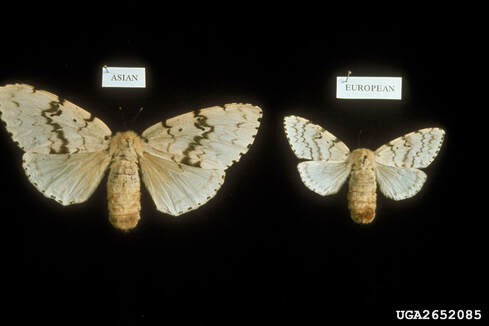Lymantria Moths
Lymantria moths (formerly known as gypsy moths, now with a common name spongy moths) have been present in Michigan since the 1980's and the first major outbreaks began about a decade later. Since then, outbreaks have occurred on a cyclical basis - typically every 12-15 years. Fortunately, disease and predation will typically manage these high populations of moths. However, it can take several years for it to become evident and in this time, they can defoliate a number of different tree species.
One of the best ways to help prevent an outbreak is to familiarize yourself with what Lymantria moths and their egg masses look like. Those can be destroyed and thousands of moths can be stopped from entering the ecosystem. It's also very important to burn firewood where you find it! Moths and their eggs can be invisible hitchhikers on wood and easily moved from one place to another. For more information on the Lymantria moth life cycle and their management in Michigan, visit Michigan State University's "Integrated Pest Management" website.
One of the best ways to help prevent an outbreak is to familiarize yourself with what Lymantria moths and their egg masses look like. Those can be destroyed and thousands of moths can be stopped from entering the ecosystem. It's also very important to burn firewood where you find it! Moths and their eggs can be invisible hitchhikers on wood and easily moved from one place to another. For more information on the Lymantria moth life cycle and their management in Michigan, visit Michigan State University's "Integrated Pest Management" website.
|
Did you know there are actually two different species of Lymantria moth? One is originally from Asia (and is much larger) and the other is European.
Learn more about each species! Asian Lymantria Moth
|

